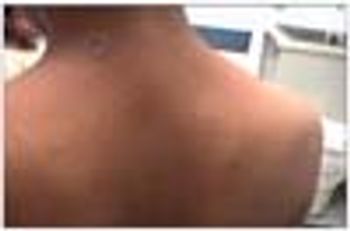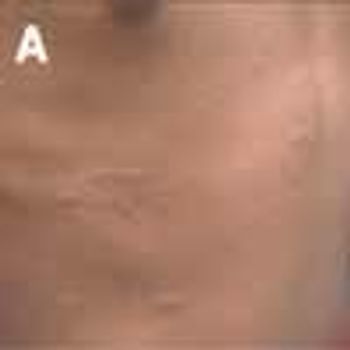
In the course of studying azithromycin as a treatment for pityriasis rosea (PR) which we found does not work, we collected much data on the distribution, morphology, and course of the lesions.

In the course of studying azithromycin as a treatment for pityriasis rosea (PR) which we found does not work, we collected much data on the distribution, morphology, and course of the lesions.

Warning: this is a column about political correctness. If you find it impossible to be judgmental in any situation, or are incapable of offering decisive opinions about anything, you are advised to go no further-your feelings will be hurt.

An 11-day-old African American boy was brought in for a well-baby visit. Pregnancy, labor, and delivery had been uncomplicated.

When I was growing up in Brooklyn in the 1950s, kids started their preparations for Halloween after dinner on October 31. We would find an old mask, or make one out of a paper bag; wealthier kids might buy one. I would grab a pillowcase to hold my "loot" and take off. Neighbors would give us store-bought candy or homemade cookies or cupcakes. It didn't occur to anyone that an unwrapped, unsealed item could be dangerous. Older kids were the real danger: they would steal our goodies and often beat us up.

This story was told to me by Dr W, a pediatric resident whom I run into every now and then. He swears that it's true. He had an afternoon to kill one Sunday in late August, before taking call that night, so he went to the Hamtramck Street Festival. Hamtramck is a small city completely surrounded by the city of Detroit. Until 20 or 25 years ago, it was populated nearly almost entirely by families of Polish origin--immigrants and their descendants. Then, as in other Rust Belt cities, time and unemployment produced some drastic changes. The city became poorer; physical decay became more evident. Immigration from Albania, Yugoslavia, the Middle East, Pakistan, and Bangladesh reduced the Polish majority. Still, it's the only city in North America that has a park with a statue of Pope John Paul II. "A touch of Europe in America" say the bumper stickers.

This happened over 25 years ago, but she remembers it clearly. . . . at the time, she was a pregnant intern on the infant-toddler ward of the busiest children's hospital in the Midwest. It was December, and the ward was jumping. One of her patients, Tony, a 3-month-old with tracheomalacia and severe croup was sick and not improving much. Tony's mother was worried mainly about her son, but there were other things. She had recently come north after being laid off in Alabama. Her unemployment had quickly led to homelessness. She had a brother in town, and she had moved in with him. When she arrived, she found out that he was a heroin addict. He was uninterested in her and her son, and his house was unsafe.

It was my first day back at the office after a 2-month medical leave, which included 14 days of hospitalization for severe depression. I'd had plenty of time to ponder whether this was an endogenous or exogenous depression. There were many things that could have caused me to be depressed: the death of my wife a few years ago, a pediatric career devoted-in large part-to abused children, conflicts between the medical school and the hospital, administrative decisions forcing my division to "do more with less" that made life difficult, and a general pervasive attitude that making a profit mattered above anything else.

I'm a pediatrician who started out with some interest, and eventually developed some expertise, in what is euphemistically called child protection. I'm glad that child protection occupies only about 20% of my clinical time--it's more than I could bear full-time. After 25 years in this field, I have heard many stories. Here is one I can't forget.

A 27-month-old boy is brought by his mother to the emergency department (ED) with a 1-day history of sluggish behavior and unsteady gait. The child had been sleepy but was arousable.

This past February, I wrote an editorial for this journal called "Skeptical Sentiments."1 In that essay, I mentioned the satisfaction I had derived from helping children and families during my 30-year career as a pediatrician. I also listed a series of things and situations I have learned to distrust. Chief among them were:

A 9-day-old boy was brought in for routine care. His mother had noticed these teeth at the child's birth. There were no other remarkable physical findings. Natal teeth occur in 1:700 to 1:6000 births, write Howard Fischer, MD, and Ahdi Amer, MD, of Children's Hospital of Michigan in Detroit. Such teeth are most often seen in the mandibular incisor area, often in pairs.

Medicine is at least as much art as science. Often things are not clear-cut, but rather appear in shades of gray. We offer the following list of terminology for those who don't mind thinking in terms of black or white.

Seven-year-old girl with generalized rash that started as a single isolated oval lesion on the lower abdomen. Six days later, diffuse papulosquamous lesions appeared mainly on the trunk, sparing the scalp, face, and extremities. Intense itching despite 3 days of diphenhydramine therapy.

I've learned (the hard way) that many parents of chronically ill children are sensitive and reliable observers of their children. What prevents physicians (at all levels of training) from failing to appreciate this fact?

I have been a pediatrician for nearly 30 years. I have practiced in affluent suburbs and in poor inner cities and have cared for patients from many religious, ethnic, and cultural backgrounds. Experience has taught me that there are certain ways to approach a child's parents that are nearly universally appreciated.

The mother of this 5-month-old infant was concerned about the lesions that appeared on her son's inner ankles after he had spent the day with his babysitter. The lesions had not been present when the child was dropped off earlier that morning. His grandmother feared they might be cigarette burns.

Published: August 1st 2006 | Updated:

Published: July 1st 2007 | Updated:

Published: August 1st 2006 | Updated:

Published: September 1st 2007 | Updated:

Published: September 1st 2005 | Updated:

Published: July 1st 2006 | Updated: